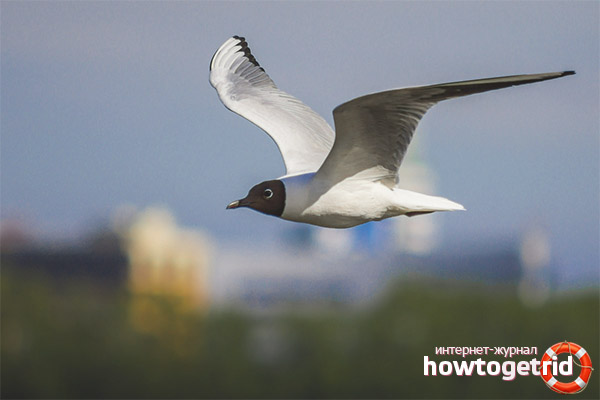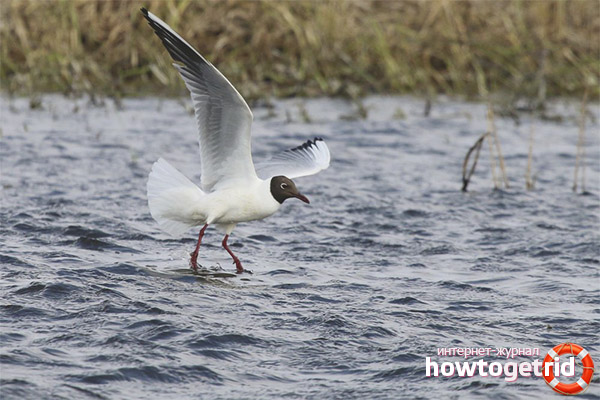The content of the article
At the word “seagull”, the imagination draws a snow-white beautiful proud bird, sedately soaring above the sea surface. But in reality, gulls live in any more or less large reservoir, not only at the sea, and there are more than 20 species of them. Today it will be a bird who chose water reservoirs far from the sea for housing - even in cities lakeside gulls settle.
Description
The black-headed gull belongs to the gull family, and the charadriiformes. Appearance is the same as in the birds of this family - a dense constitution, the plumage is smooth, the tail and wings are not too long, not very short. In terms of its size, it is inferior to congeners of other species - a small bird, a bit more urban pigeon.
- Body length - from 38 to 44 cm.
- Mass - 200-350 g.
- Wingspan from 95 to 104 cm.
- The beak is red, somewhat curved, with notches on the inside (so that the fish do not slip out).
The mandible bright red saturated color. - Plumage mostly white and pink. The wings are mostly light gray.
- Paws of the same color as the beak are red.
Young birds are gray-brown in color, with many red and brown spots on the wings. Legs with a beak are painted in yellow colors of dark tones. The tail is decorated with a strip of dark brown color.
Habitat
It is distributed almost everywhere throughout Eurasia - from Iceland and the British Isles to the Far East, the Kuril Islands and Kamchatka. It lives even in the inhospitable cold north - the nests of black-headed gulls are found in Greenland, the Scandinavian countries and some North American regions.
They also inhabit the south of France, the north of Italy, and the post-Soviet space - in the Crimea, the Caucasus region, Turkestan.They live in the near-lake regions of Mongolia.
Nutrition
It mainly feeds on insects, loves worms - it extracts them both in water and on land. It also catches crayfish, mollusks, various small fish such as bleak. It catches small birds, ruins their nests. Quite cleverly it turns out to catch insects in the meadows - grasshoppers, dragonflies.
You can often see flocks of birds searching for food near fish processing plants - they collect unprocessed waste. Visiting and landfill, collecting discarded food residues. When there is nothing to eat, they are looking for plant seeds - however, such food is consumed only at the time of starvation. Do not hesitate to eat carrion.
When fishing, the bird dives incompletely, only partially dives into the water of the head.
Nesting
Sexual maturity comes in the second year of life. Moreover, females become sexually mature a little earlier than males. Birds remain faithful to one partner, that is, monogamous. It happens that in order to find a permanent life partner, you have to make several attempts, living with different partners.
Gulls nest in colonies whose size varies from 5-6 pairs to several hundred, or even thousands of birds.Often the colonies are heterogeneous in composition, there may be other species of gulls or terns.
Nests are arranged on bumps in reservoirs with stagnant or slow flowing water in places that are difficult for people and animals to access.
Last year’s dried sedge, reed, cattail and all that a seagull is able to find is used as a building material. Any wallowing garbage is suitable for construction - scraps of nets, canned cans, feathers and so on.
The nest device is very simple - a low, cone-shaped flooring with a round bottom is made of plants and materials at hand, in the middle of which a recess for eggs is constructed. If the place is dry, then the flooring is thin, but the more moisture in the construction site, the denser and thicker the bottom. In the construction involved both representatives of the pair.
The laying consists of 3 eggs of gray or bluish color, speckled with brown spots. The female incubates the eggs for two or three and a half weeks. Around the middle of May, chicks appear, and they are born already covered with feathers of ocher-brown or black-brown color. This color plays a camouflage role and allows you to be invisible to enemies.Children are in the nest for 10-12 days, fed by their parents. Both birds are involved in this process. Feeding takes place in a standard way - either the chicks are fed from the beak to the beak, or the food is placed on the bottom of the nest, and the little ones pick and eat it. About a month later, the young birds begin to try to fly.
Wintering

Most seagulls spend the winter on the Mediterranean coast, the north of the African continent or the countries of Eastern Europe. On the territory of the post-Soviet space, warm southern regions are chosen for the winter period - the Caspian or Black Sea coast, the lakes Issyk-Kul and Balkhash.
Interesting Facts
- As soon as a young individual learns to fly, it immediately leaves the parental nest.
- The black-headed gull belongs to those few species that live not only in areas near the sea, but also in the depth of land.
- The bird's appetite is good, it is quite a voracious bird. Eats about 200-230 grams of insects per day. And that, not counting the fish.
- In places of nesting there is a non-extinguishing constant din and noise. Often it comes to squabbles and fights.Moreover, any trifle can serve as a pretext: for example, two birds quarreled because of a piece of fish and, right there, a good part of the colony can hang in the quarry.
- The gull's voice is peculiar - difficult to characterize. Here and laughter, and the cry of an angry cat, and the similarity with the cry of a crow. Gulls scream all the time, never shut up.
- If, during the period of incubation or feeding of children, somewhere nearby, danger or an uninvited guest is noticed, the whole colony begins to worry - the birds take off, wail heart-rending, trying to pour the litter on the offender as much as possible.
- Gulls tend to eat not only the eggs of other birds, but also neighbors in the colony. Sometimes they even eat chicks. Therefore, birds sometimes have to lay several times.
Video: black-headed gull (Chroicocephalus ridibundus)












To send